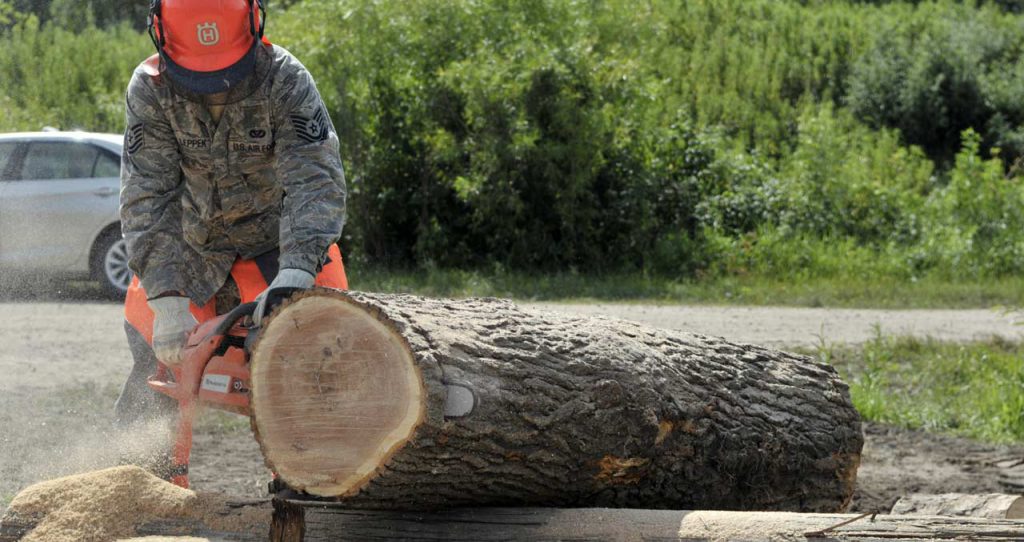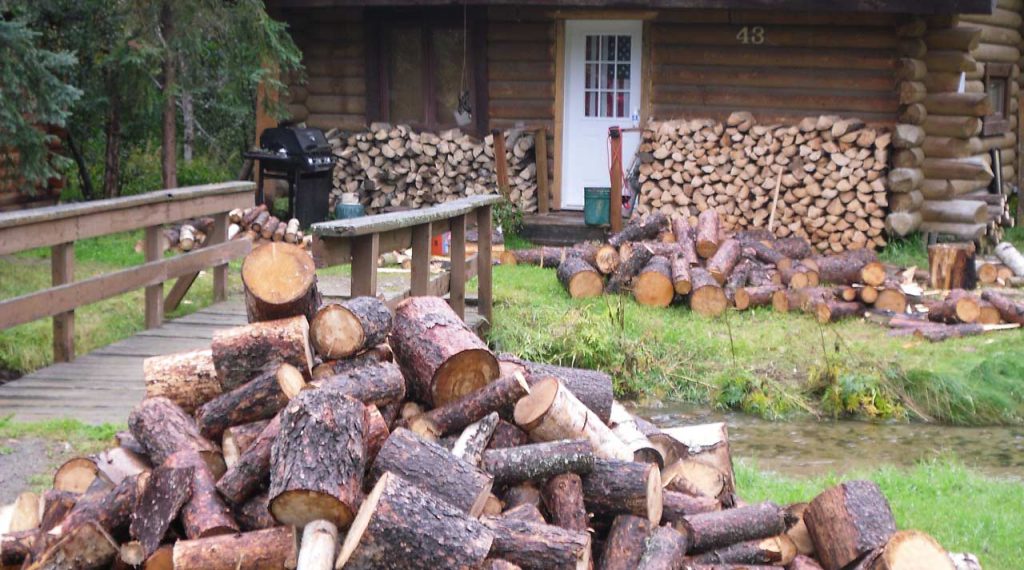
If you use your chainsaw regularly it will soon slowly lose its sharpness.
Going from being like a knife cutting through butter to… well a knife cutting through wood.
The great thing is though learning how to sharpen a chainsaw is quick, easy and cheap!
So let’s take a closer look.
Put simply:
This dullness is caused by the gradual wear of the tiny individual steel teeth found along the chain and which are responsible for its cutting ability. A dull chainsaw will exhibit certain signs that will be observable whenever it is being used.
How To Spot a Dull Chainsaw
The most prominent indicators of a dull chainsaw are;
- Strong vibrations and rattling noises
A dull chainsaw will struggle to cut through anything. These vibrations are produced when the teeth encounter tough lumber. Additional vibrations may also be caused by the engine as it strains to drive the chainsaw through the wood. - Production of fine sawdust when cutting
A sharp chainsaw should produce long strands of wood shavings whenever it is used. A dull chainsaw on the other hand produces fine sawdust since the cutting teeth can only be able to scrape through the wood as opposed to slicing through it. - Need for extra force when being used
Chainsaws are not designed to be manually pushed through whatever is being cut. One only needs to make sure the chain is in constant contact with the lumber and it will slice its way through by itself.
When the chain becomes dull however, extra force from the user may become necessary to drive the blunt chainsaw into the wood. This is not only a grueling affair but also a safety risk due to the possibility of kickbacks occurring.
The important thing is:
Whenever a chainsaw becomes dull, it needs to get sharpened right away. Doing this will prevent its destructive wear and tear and make it less risky to use.
Sharpening a chainsaw is quite easy and this article will show you how to do this by hand using a chainsaw file. This is a specially designed file used for sharpening chainsaw blades and it can be bought in a hardware store or any other store dealing in chainsaw supplies.
Ok I am ready, are you?

Parts Of A Chainsaw
Before you start sharpening the chainsaw, it is important to know all the parts that make up the cutting chain of your saw;
- The revolving chain – This chain comprises of tiny metallic links joined together by steel rivets. It is directly connected to the engine and it holds the saw’s cutting teeth.
- Guide Bar – The guide bar is a metallic platform upon which the revolving chain is set. It contains a rotating sprocket wheel which helps the chain to revolve smoothly. As its name suggests, it is used to guide the chainsaw towards whatever needs to be cut.
- Cutters – These are sharp steel teeth are attached onto the chain. They perform the chainsaw’s cutting function, meaning that their sharpness is crucial for smooth operation of the chainsaw. When a chainsaw becomes dull, it is these cutters that are usually sharpened.
- Depth Gauges (rakers) – These are metallic protrusions that are placed next to each cutter along the chain. Their main function is to determine how deep the cutters will go into whatever is being cut.

What You Will Need
- Bench vice – This will be used to hold the chainsaw in position while you sharpen the cutters.
- Chainsaw file – This is a round file specifically made for this purpose. These files come in different sizes (diameter). The file diameter suitable for your chainsaw will depend on the gauge of its chain.
You can find the gauge of your chainsaw and the recommended file diameter on its owner’s manual. This type of file also comes with an angle guide to help you position the file in the correct angle while sharpening. - Heavy duty hand gloves – Chainsaw cutters are very sharp and they can easily cause injuries even when the chain is not spinning. A pair of heavy duty gloves will ensure that your hands remain safe while you sharpen the cutters.
- Goggles – These will provide protection to your eyes against the tiny iron filings that will be produced when sharpening the chainsaw.
- A felt pen
- A depth gauge guide
Preparing The Chainsaw For Sharpening
Engage the chain brake to ensure that the chainsaw doesn’t accidentally start while you are still sharpening it. Using a piece of cloth, wipe off any grease or wood chippings from the guide bar and the chain.
Place the chainsaw on a flat surface and clamp the bench vice onto the guide bar to hold it upright.
And boom you are ready to go!

Sharpening The Saw
- Use the felt pen to mark the cutter you intend to begin with.
This will help you keep track of your progress as you work your way along the chain. If you fail to do this you may not be aware of which cutters you have sharpened and which ones you are yet to sharpen. - Place the file angle guide on the chain.
This guide is engraved with markings showing the angles through which you will be able to sharpen the cutters. The specific angle suitable for your chainsaw will be found on its owner’s manual. - From a horizontal position, place the file on the cutter and use the guide to adjust it to the angle recommended by the manufacturer.
Push the file across the cutter’s edge to sharpen it, making sure you maintain the recommended angle always. You can make up to ten sharpening strokes per cutter, depending on how dull the chainsaw was. - Repeat the same process on all the cutters along the chain.
Make sure that all cutters receive the same number of filing strokes to ensure uniform sharpness. - Once you are done sharpening the cutters, you will need to inspect the levels of the depth gauges (rakers) using the guide.
The depth gauges limit the cutting depth of the chainsaw. They need to be maintained at a level a few millimeters shorter than the cutter (the gauge will indicate the right height for your chainsaw). This height difference has to be maintained always. If the rakers are too long, they will prevent the chainsaw from cutting through anything. If they are filed too low, the chainsaw will vibrate excessively during use. - Place the depth gauge guide on the chain and if the rakers are longer than the height level indicated on the guide, you will need to file each of them down to the required size.
- While filing down the rakers, always ensure that the depth gauge guide remains on the chain. This will not only help you maintain the right height for the rakers but also ensure that you do not accidentally file down any cutter.
After the rakers have been filed down, the chainsaw will be ready for use. If you followed all the steps shown above correctly, you should have a top notch chainsaw and you will notice a remarkable improvement in your chainsaw’s cutting power.
USEFUL RESOURCES
Want to learn more about chainsaws, you can find more information here:
- Find out how to safely use a chainsaw
- Check out some of the top chainsaws on the market
- 7 Chainsaw Safety Rules


Great article on how to sharpen a chainsaw. I’ve bookmarked it to show my husband. He has two chainsaws. His main one and a backup should the main one get stuck or is at the shop getting sharpened.
How long does it take you to sharpen a saw? Is it very time consuming?
Hi Karen – ah this could be useful for your husband! If you keep on top of your chainsaw and maybe give it a quick sharpen after every tank of fuel, you can easily do it in five minutes. If however you have left it a long while and the chain is seriously in need of sharpening it can take up to 30 minutes. I guess the moral of the story is to keep on top of it!
Thank you for all that valuable information about the sharpening of chainsaws. I definitely will not be using a chainsaw myself, but I have family members who more than likely will be using one of these tools in the near future.
Among the great information you provide, I particularly like mention of heavy duty gloves and the googles.
I am bookmarking your website for future reference and to educate family members on sharpening their chainsaw.
Thank you Valerie, chainsaws can be dangerous tools in the wrong hand so I am glad to see you are looking out for your family members! I hope to educate you and your family in the future with more articles!
Regards, Steve